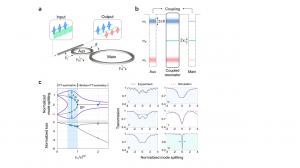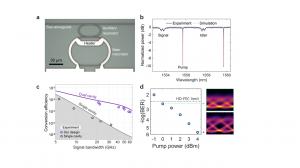Parity-time symmetry: unlocking faster and stronger optical signal processing
USA, May 10, 2024 /EINPresswire.com/ -- Signal processing is a fundamental necessity for modern society but facing significant trade-off between speed and efficiency. Towards this goal, scientist in China, Denmark and US invented a unique integrated microresonator system, that creates different states for the light that resonate at different frequencies, and allows optical signal to be processed faster and stronger. This innovation (https://doi.org/10.1186/s43593-024-00062-w
) paves the way for fully chip-scale nonlinear signal processing devices that may revolutionize classical and quantum communication and computation.
In the era of big data, signal processing faces significant challenges in terms of capacity and energy consumption due to the torrent of data to process. With over 90% of data transmitted through light, optical signal processing may offer unprecedented speed and energy efficiency compared to its electronic counterparts, as it operates without the need to convert the optical data stream into the electrical domain. Optical nonlinear effects, known for their ultrafast response, large bandwidth, and parallelism, combined with integrated photonics platforms, can provide an efficient optical control technique to advance the development and application of optical signal processing.
Yet, the demanding requirement for a high-intensity light field still remains a major impediment to realizing practical nonlinear optical signal processing (NOSP) systems. Resonant devices, typically employed to reduce power requirement in nonlinear applications, faces a restrictive trade-off between speed and efficiency in NOSP applications, which means boosting efficiency is often traded off by scarifying speed.
Recently, researchers have pioneered a groundbreaking method that markedly enhances the efficiency and speed of NOSP simultaneously. This new approach utilizes a specially designed microresonator system that manipulates light using a principle called "parity-time (PT) symmetry". Originating from quantum field theory, PT symmetry can be realized in optical systems with a spatially balanced gain-loss distribution. Coupled systems with low-/high-loss subsystems can be regarded as passive PT systems via mathematical transformation.
To overcome the bandwidth-efficiency (speed-efficiency) trade-off, leveraging loss (cavity decay) through PT symmetry is crucial. While the loss is often viewed as a shortcoming of a system, it can broaden resonator linewidths to accommodate broadband signals. Researchers devised a way to manipulate loss for the light waves participating in the NOSP where the light wave (pump wave) driving the NOSP experiences low loss thus being greatly boosted in its intensity through resonance enhancement, whereas the optical data stream that is subject to optical signal processing (signal and idler waves) experiences a higher loss – in other words, selectively damped resonance – so that the system can facilitate the high-speed modulated light. The two distinct phases that arise from PT symmetry breaking, the most intriguing feature of PT systems, fit into this requirement nicely.
To achieve this goal, researchers developed a special coupled microresonator system, with one microresonator being half the length of the other. This design enables the incorporation of both the PT-broken phase and near-exceptional point PT-exact phase in different spectral windows simultaneously within the same structure. As a result, high-efficiency and high-speed operation can be achieved simultaneously, effectively breaks the bandwidth-efficiency limit imposed on single resonator systems.
Breaking the bandwidth-efficiency limitation of conventional microresonators means faster speeds. Researchers showed experimental evidence demonstrating that high-speed data processing, exceeding 38 gigabits per second, can be achieved with high-quality factor microresonators featuring intrinsic linewidths as narrow as 1 gigahertz. This achievement in both increased efficiency and speed enables a two-orders-of-magnitude improvement in efficiency compared to single resonator systems.
This innovation ultimately results in significantly reduced power consumption required for performing high-speed signal processing tasks. By combining the concept with an ultra-high nonlinear integration platform, i.e., AlGaAs-on-Insulator, researchers demonstrated NOSP operation (wavelength conversion) of a 38 GBaud on-off-keying signal with only 1mW pump power. This record-low pump power operation forecasts fully chip-scale nonlinear signal processing devices in the near future.
This breakthrough tackles the practical challenges of implementing the NOSP system, fostering their real-world deployment. The smaller, faster, and more efficient devices made possible by PT-symmetric NOSP have the potential to bring about substantial improvements in network capacity, speed, and energy efficiency. These advancements could lead to faster internet speeds, more efficient data centers, and even new applications in quantum computing.
The researchers are optimistic about the real-world impact of their work. They anticipate that the PT-symmetry-based linewidth manipulation technique will attract broad interest, given its potential applications across various fields such as optomechanics, acoustics, and atomic physics and engineering. They believe that this work will also resonate with a wide and interdisciplinary audience, as it brings the mindsight that loss can be a valuable commodity and can be harnessed to solve the contradiction between efficiency and speed, which is a common challenge exists in our daily lives.
DOI
10.1186/s43593-024-00062-w
Original Source URL
https://doi.org/10.1186/s43593-024-00062-w
Funding information
This work was supported by the National Key Research and Development Program of China (2019YFB2203100), the National Natural Science Foundation of China (NSFC) (No. 62275087), the European Research Council (REFOCUS 853522), the Danish National Research Foundation, SPOC (ref. DNRF123), and the Knowledge Innovation Program of Wuhan-Shuguang Project (No. 2022010801010082).
Lucy Wang
BioDesign Research
email us here
Legal Disclaimer:
EIN Presswire provides this news content "as is" without warranty of any kind. We do not accept any responsibility or liability for the accuracy, content, images, videos, licenses, completeness, legality, or reliability of the information contained in this article. If you have any complaints or copyright issues related to this article, kindly contact the author above.


